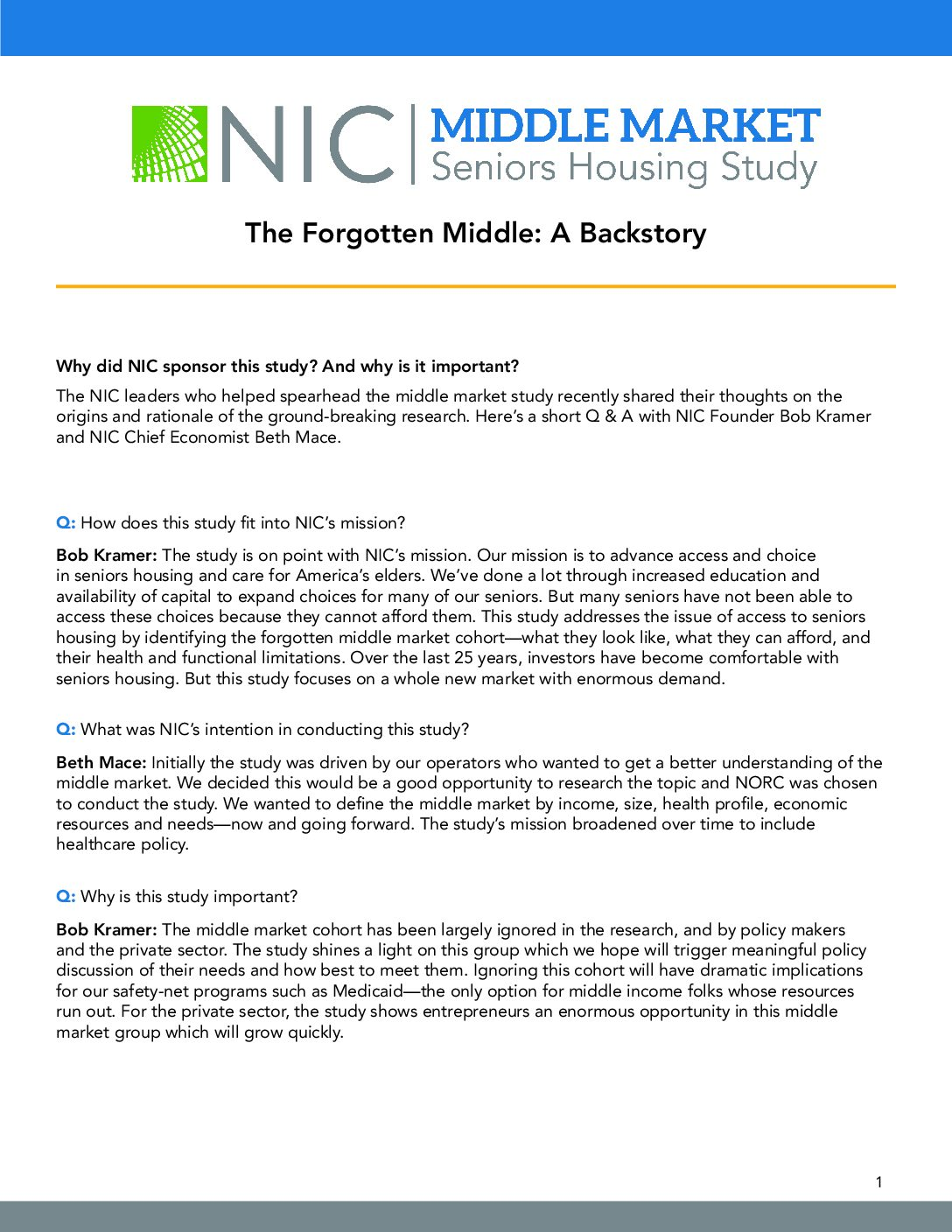Why did NIC sponsor this study? And why is it important?
The NIC leaders who helped spearhead the middle market study recently shared their thoughts on the origins and rationale of the ground-breaking research. Here’s a short Q & A with NIC Founder Bob Kramer and NIC Chief Economist Beth Mace.
Q: How does this study fit into NIC’s mission?
Bob Kramer: The study is on point with NIC’s mission. Our mission is to advance access and choice in seniors housing and care for America’s elders. We’ve done a lot through increased education and availability of capital to expand choices for many of our seniors. But many seniors have not been able to access these choices because they cannot afford them. This study addresses the issue of access to seniors housing by identifying the forgotten middle market cohort—what they look like, what they can afford, and their health and functional limitations. Over the last 25 years, investors have become comfortable with seniors housing. But this study focuses on a whole new market with enormous demand.
Q: What was NIC’s intention in conducting this study?
Beth Mace: Initially the study was driven by our operators who wanted to get a better understanding of the middle market. We decided this would be a good opportunity to research the topic and NORC was chosen to conduct the study. We wanted to define the middle market by income, size, health profile, economic resources and needs—now and going forward. The study’s mission broadened over time to include healthcare policy.
Q: Why is this study important?
Bob Kramer: The middle market cohort has been largely ignored in the research, and by policy makers and the private sector. The study shines a light on this group which we hope will trigger meaningful policy discussion of their needs and how best to meet them. Ignoring this cohort will have dramatic implications for our safety-net programs such as Medicaid—the only option for middle income folks whose resources run out. For the private sector, the study shows entrepreneurs an enormous opportunity in this middle market group which will grow quickly.
Q: What do you hope comes from this study?
Beth Mace: We hope this study begins a focus on this group of seniors leading to action steps where we produce care and housing options that middle income seniors can afford to improve their quality of life.
Bob Kramer: The search for solutions must come from discussions between the public and private sectors. They will have to work together to tackle the high cost of housing and care. One example might be to create more flexible policies around caregiving. But the answer isn’t just a policy solution or a market-driven solution. We hope this study begins a joint discussion between public and private stakeholders that leads to action.
Q: Why are the results of this study are being disseminated at a policy forum with Health Affairs in Washington, D.C., on April 24, and then at an investor summit in New York on May 21?
Bob Kramer: NIC has never done anything in the policy realm. We are not an advocacy organization. But we realize the study has major policy implications, so we are thrilled to partner with Health Affairs. They have great credibility in the policy world as do the other the organizations that have joined with us, including The SCAN Foundation, AARP, the AARP Foundation, and the John A. Hartford Foundation. At the same time, NIC has credibility with developers, investors and providers. So we are taking the lead to host the investor summit in New York, along with Institutional Real Estate Inc., and Real Capital Analytics. By holding a policy forum and an investor summit, we are showing that the solution to the need for more middle market seniors housing involves both the public and private sectors.
Q: What are some of the implications for the private sector from this study?
Beth Mace: I think new and innovative financial structures for debt and private equity could emerge, as well as possibly new sources of capital. Perhaps it would be a retail investment product, or a new structure altogether. I’m excited to be involved with the New York investor summit to hear ideas from the private sector. I think the study will also spark some ideas on how to lower the cost of project development. The private sector will be an important partner in the challenge to house the elders of the forgotten middle market.
